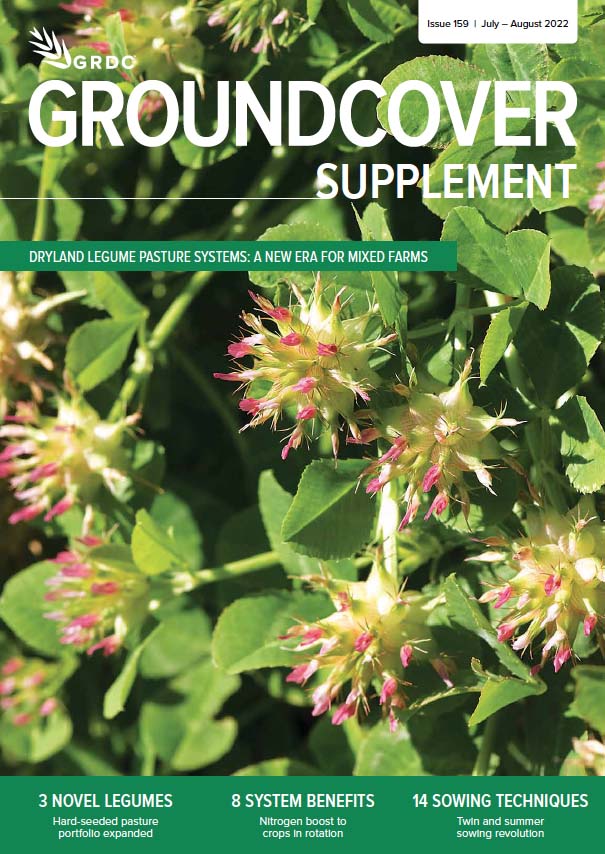This page shows the articles in of GroundCover.
GroundCover is also distributed every two months via mail. If you would like to subscribe to receive the hardcopy magazine, visit our subscription page.
Download supplement-

Novel legumes boost mixed farm profits
Supplement: Dryland Pasture Systems, July-August 2022 - 29 06 2022The $18 million Dryland Legume Pasture Systems project has worked for five years across four states with investment from the Australian Government Department of Agriculture, Water and the Environment as part of its Rural R&D for Profit program and supported by GRDC, Meat & Livestock Australia and Australian Wool Innovation. It has successfully identified better-adapted, novel, hard-seeded legume species and matched them with low-cost production practices, providing a step change for low to medium-rainfall growers.
-

Novel pasture legumes pass the livestock test
Supplement: Dryland Pasture Systems, July-August 2022 - 23 06 2022Livestock nutrition research undertaken as part of the Dryland Legume Pastures System project has identified unique features of novel legume species that provide benefits for mixed growers in low to medium-rainfall regions. In WA and NSW these species are able to develop more biomass from summer sowing which extends their grazing period. Some have improved survival when ingested by sheep, pods and seeds that are more digestible than subclover, and animal live weight gains at the end of the growing season are often increased.
-

Harvest tips for hard-seeded pasture legumes
Supplement: Dryland Pasture Systems, July-August 2022 - 23 06 2022The aerial-seeded feature of novel pasture legumes, identified by the Dryland Legume Pastures System project, enables them to be direct headed with conventional machinery to fit easily into conventional cropping enterprises. But there are tips and tricks for some species.
-

Modelling underscores hard-seeded legume prospects
Supplement: Dryland Pasture Systems, July-August 2022 - 23 06 2022Crop and pasture sequence models can provide useful biological and economic performance data for growers considering new practices. Hard-seeded pasture legumes have been put through this exercise, which shows they are profitable and have roles in business diversification and reducing risk and costs.
-

Sowing strategies in SA and Victoria
Supplement: Dryland Pasture Systems, July-August 2022 - 23 06 2022Research on novel sowing methods undertaken in southern Mallee environments as part of the Dryland Legume Pasture Systems project has begun to match adapted species to environments to improve productivity.
-

The hard-seeded nature of novel pasture legumes
Supplement: Dryland Pasture Systems, July-August 2022 - 23 06 2022Understanding the breakdown patterns of hard-seededness in pasture legumes influences selection of the best species and variety adaptation to an environment.
-

Twin and summer sowing pasture revolution
Supplement: Dryland Pasture Systems, July-August 2022 - 23 06 2022Twin and summer sowing methods have been developed to capitalise on the hard seed feature of novel pasture legume species for low and medium-rainfall regions of Australia. These innovative management practices developed by the Dryland Legume Pastures System project are providing growers with more sustainable and agile crop and pasture systems with reduced risk.
-

Rotational benefits from resilient pastures
Supplement: Dryland Pasture Systems, July-August 2022 - 23 06 2022The Dryland Legume Pasture Systems project has determined that vetch remains the best option on neutral/alkaline sandy soils in medium-low rainfall regions of SA and Victoria when a sown legume ley is needed for one year, while annual medics are preferred for self-regenerating pastures. In both scenarios legumes provide benefits for following crops. This comes after the evaluation of a range of legume pasture species for mixed farming systems.
-

Pasture legume improvement for alkaline soils in SA and Victoria
Supplement: Dryland Pasture Systems, July-August 2022 - 23 06 2022Annual medics have been the best performers on neutral to alkaline soils in the low-medium rainfall zones of SA and Victoria. New medic varieties are coming onstream with novel traits, and other more easily harvestable legumes also show promise for this zone.
-

Pastures that can supercharge crop sequences
Supplement: Dryland Pasture Systems, July-August 2022 - 23 06 2022The nitrogen boost to subsequent crops is just one of many benefits from adding novel hard-seeded legume pasture species to low and medium-rainfall mixed farming systems. Western Australian researchers have quantified these and other benefits to support growers’ decisions to use these species.


























































